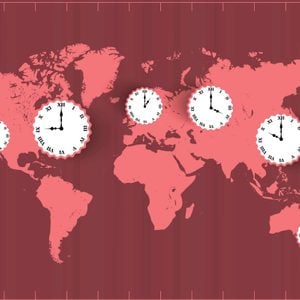What Do AM and PM Stand For?
Updated: Aug. 11, 2021

We use these abbreviations all the time, but do we actually know what they mean?
Many of the English words and expressions we use daily can trace their origins back to Latin, and this is true for some of the English language’s more perplexing abbreviations and acronym examples. “Lb,” the seemingly out-of-the-blue abbreviation for “pounds,” comes from the Latin phrase “Libra pondo.” “No.” as an abbreviation for the decidedly O-less word “number” comes from the Latin “numero.” And, if you’ve ever wondered, “What do AM and PM stand for?” look no further: These common abbreviations come from Latin too. (And, by the way, what’s the difference between acronym vs. abbreviation?)
What do AM and PM stand for?
In the United States and several other English-speaking countries, we use these abbreviations all the time. The correct use of them makes or breaks our alarm-clock settings. And yet many people can’t correctly answer the question “What do AM and PM stand for?”
Well, if you’re one of those people, wonder no more. “AM” stands for “ante meridiem.” The Latin phrase “ante meridiem” means “before noon” or “before midday.” That’s why, in the 12-hour system, all times from midnight onward use this designation. PM stands for “post meridiem,” meaning “after noon” or “after midday,” and as such applies to the times from noon onward. English-speaking countries have been using the “AM” and “PM” abbreviations since the 17th century. The Latin word “post” has also made its way into our language on its own, synonymous with “after.” To unlock some more time mysteries, find out why we have daylight saving time.
How to punctuate AM and PM
Do you need to capitalize “AM” and “PM”? Should it be A.M. and P.M. since they’re abbreviations? Can they, or should they, be lowercase? Well, when it comes to formatting AM and PM, the “rules” aren’t as strict as you think. While both Chicago and AP styles recommend writing them as lowercase letters with periods (“a.m.” and “p.m.”), most combinations are considered OK, as long as you’re consistent with how you write them. You can write them uppercase, lowercase, or even as small caps if you have that formatting ability. And when you’re using periods and the abbreviation ends a sentence, you don’t need an extra period—as in “I RSVP’d to that party, please pick me up at 12 p.m..” By the way, what does RSVP stand for?
AM and PM in military time
If you’re using military time, or the 24-hour system, you don’t need AM and PM because there are no duplicate numbers. Instead of going back to 1 after 12:59 (PM), you move on to 13:00. And the hour just after midnight is different too so there’s no double-12.
- From midnight (12:00 AM) until 12:59 AM, swap the 12 for a zero.
- If you’re in military time and trying to translate back to the 12-hour system, any time that begins with zero is 12-something AM.
- To identify how a post–12:59 PM time translates into military time, add 12 to the hour number.
- If you’re in military time, subtract 12.
| Time Formats | |
| 12-hour | 24-hour |
| 12:00 (midnight) | 0:00 (beginning of the day) |
| 12:01 a.m. | 0:01 |
| 1:00 a.m. | 1:00 |
| 2:00 a.m. | 2:00 |
| 3:00 a.m. | 3:00 |
| 4:00 a.m. | 4:00 |
| 5:00 a.m. | 5:00 |
| 6:00 a.m. | 6:00 |
| 7:00 a.m. | 7:00 |
| 8:00 a.m. | 8:00 |
| 9:00 a.m. | 9:00 |
| 10:00 a.m. | 10:00 |
| 11:00 a.m. | 11:00 |
| 12:00 (noon) | 12:00 |
| 12:01 p.m. | 12:01 |
| 1:00 p.m. | 13:00 |
| 2:00 p.m. | 14:00 |
| 3:00 p.m. | 15:00 |
| 4:00 p.m. | 16:00 |
| 5:00 p.m. | 17:00 |
| 6:00 p.m. | 18:00 |
| 7:00 p.m. | 19:00 |
| 8:00 p.m. | 20:00 |
| 9:00 p.m. | 21:00 |
| 10:00 p.m. | 22:00 |
| 11:00 p.m. | 23:00 |
| 12:00 (midnight) | 24:00 (end of the day) |
So 3:45 PM would become 15:45. Scratching your head at what time “21:39” is? Subtract 12 from the hour to get 9:39 PM.
The biggest moment where this gets dicey can be midnight: Is midnight 0:00, or 24:00? Well, this can be a good way to differentiate between the preceding midnight and the upcoming midnight, or the beginning of a certain day and the end of that day.
What about noon and midnight?
One of the most confusing aspects of the AM-PM system, once you’ve answered the question “What do AM and PM mean,” is how it accounts for midnight and midday. The confusion that can arise from having two of every “o’clock” a day is definitely a solid argument in favor of using military time. So, in the 12-hour system, which 12:00 is which?
Technically, 12:00 at night, which we know as “12 AM,” is exactly 12 hours after the previous noon and before the coming noon, so does it count as “before” noon or “after” it? And, of course, 12:00 PM is noon, so it may seem silly to designate it “before” or “after.” English-speaking countries parse it out by using “12:00 AM” to refer to midnight, since midnight starts the new day, so it can be considered “before noon” of the same day. Not to mention it would probably be even more confusing if time went from 12:00 PM to 12:01 AM. So noon then becomes 12 PM by default.
Though, if you’re deeply linguistically opposed to calling “noon” “after noon,” there’s actually another Latin abbreviation you can use. The AM/PM system actually does have a specific abbreviation for noon—just the letter “M,” short for “meridiem,” which would come after “12” and only refer to noon. Haven’t heard of it? Well, for better or worse, the “12 M” designation for “noon” is quite rare and has been pretty much lost to antiquity. If the answer to the question “What do AM and PM mean” surprised you, find out the answer to “What does P.S. stand for.”
Sources:
- Dictionary.com: “What Do “a.m.” And “p.m.” Stand For?”
- Militarytime.us: “What Do AM and PM Stand For?”
- Proofreading Academy: “Writing the Time: AM and PM or a.m. and p.m.?”
- Timeanddate.com: “What Do AM and PM Stand For??”



